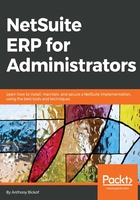
Enabling features
Go to Setup | Company | Enable Features. ACCOUNTING, ACCOUNTING PERIODS, and A/R on the Accounting tab need to be enabled for the order-to-cash process.
We can also enable specific item types, allowing us to sell different types of products. We find the options on the Items & Inventory tab:

Items and Inventory page
INVENTORY is just one of the options. It is used to purchase physical goods from a vendor and resell them to a customer while tracking the location of the inventory throughout that process.
ASSEMBLY ITEMS are items that we manufacture from components. The components are therefore set up as inventory items and the manufacturing process results in an assembly item.
MATRIX ITEMS are used to manage situations where the item can be ordered in multiple configurations. A shirt, for instance, may be sold in different sizes (small, medium, large, and extra-large), different colors (red, green, blue, and white), and with different logos (Manchester United, Chelsea, Manchester City, and Liverpool). That is a lot of permutations to manage, but the NetSuite matrix item feature helps you to do so by creating a parent item that can be used to update the various combinations very easily.
We can also create Serialized Inventory items providing the ability to track the movement of a specific piece of inventory based on its serial number. This feature necessitates entering the serial number on any transaction containing this item. Any item receipt, fulfillment, or transfer requires us to specify the specific item that was received or sent, identified by its serial number. There is also the ability to sell Gift Certificates and Downloadable Items, as well as DROP SHIPMENTS & SPECIAL ORDERS item.
The Transactions tab contains some important options, including SALES ORDERS, which recognize the customer's commitment to purchase from you and can create the instruction to the warehouse to ship the item and the accountant to invoice the sale. We can also enable RETURN AUTHORIZATIONS to record any customer returns.
The Transactions tab also contains important options regarding the fulfillment itself. ADVANCED SHIPPING splits the shipping function from the billing function, whereas PICK, PACK AND SHIP splits the fulfillment into three separate steps. This allows us to easily split those tasks among different people while the system manages the process to ensure that no fulfillments get missed.
SHIPPING LABEL INTEGRATION enables us to print FedEx, UPS, and USPS shipping labels directly in NetSuite. It automatically creates the shipping label and updates the NetSuite tracking number field with the correct tracking number supplied by those shippers.
MULTIPLE PRICES gives us the ability to charge two different customers different prices for the same items. QUANTITY PRICING, on the other hand, helps us to specify bulk discounts provided to customers if they purchase in large quantities. In the case of MULTIPLE PRICES, a wholesale customer will be charged the wholesale price even if they're purchasing only one item. QUANTITY PRICING, on the other hand, lets us charge a different price per item, if the customer purchases more than 10 items on the same order, as an example:

Sales section of the Transactions tab